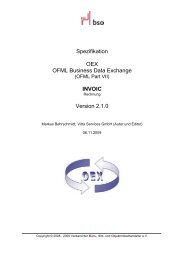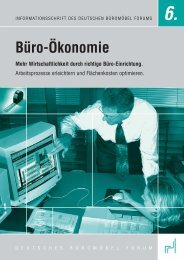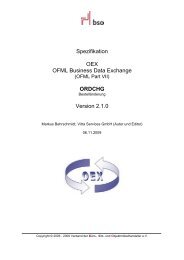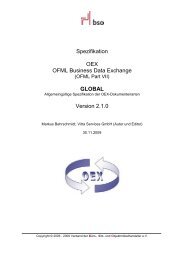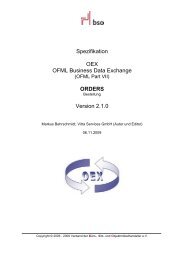New Work Order - Orgatec
New Work Order - Orgatec
New Work Order - Orgatec
- No tags were found...
You also want an ePaper? Increase the reach of your titles
YUMPU automatically turns print PDFs into web optimized ePapers that Google loves.
7<strong>New</strong> <strong>Work</strong> orderDriving forcesTheir sources aren’t solely IT or communication departments. Megatrends that aregradually becoming more relevant also play a key role. Examples include demographicchange, increasing mobility, and digital networking. The NEW WORKORDER is being driven by the initial effects related to these trends—for instance,the shortage of skilled labour and the inability of conventional work schemesto accommodate a knowledge society powered by dynamism and creativity.technologically:TransparencyGlobal networking accelerates competition andcreates a need for more data generation and automateddata processing.The expansion of communication media, theirgreater ease of use and the increasing availability ofthe Internet are simplifying access to information. Theprocesses for passing on knowledge are now more dynamic,as are value chains.Social networking is replacing e-mail:Digital natives have long since moved to communicationvia social platforms like Facebook. This has reducede-mail traffic and led to an increase in informalcommunication during the normal working day.Employee communication via social media usingmicroblogging and activity streams ensures processtransparency and thus efficient co-operation.Information transparency for sharing knowledgeand avoiding redundancy is becoming an importantfactor of success in the knowledge society.economically:EfficiencyCost pressures on international markets will increasedue to the debt crisis and digital productionstandards.Business locations: These will be selected on thebasis of market and manpower volumes. Declining demandat home and abroad, a lack of motivated skilledworkers and restrictive lending will make business difficultfor companies operating in Europe.local peculiarities are increasingly in danger ofbeing eliminated in the name of cost efficiency and replacedby headquarters standards. Their benefits (financialas well) should be more closely examinedinstead.Networking and collaboration help conserveresources. The increase in project work across departmentsand locations reflects increased flexibility.Shareholder interests are becoming more of anissue in uncertain times, which means companies alwaysneed to be able to provide access to figures andsuccess stories.integration and stimulation of all parties for a proactiveexchange of information is vital to the transferof knowledge.socially:DialogueAltered age structures caused by the demographictransformation will lead to an increase in averageemployee age and in age gaps at companies.Mobile knowledge workers, home-office workers,and freelancers in co-working spaces requiretools for transparent work and collaboration.The proximity virtual work has not been able toprovide up until now is being created by social mediathat ensure a type of communication transparency inwhich nobody is left out.With skilled labour in short supply, sharedcontent and interests are leading to new contacts andtalents, both internally and externally.Departmental and corporate boundaries arethus being broken down, and informal communicationtechniques are overlaying formal hierarchies.Professional and private interests are overlapping,as are the forms of media use.<strong>Work</strong> and leisure time are merging. Content isking and self-marketing is now a personal obligation.culturally:Motivation and loyaltyYoung skilled workers are becoming a scarce resource,which means employers must do a better jobof branding themselves to potential recruits.Identification with their job and their companyis extremely important to knowledge workers. Theywant their work to enable them to achieve their professionaland personal goals.The future will see more heterogeneous teams interms of family status, age, cultural background andreligion. Prejudices tend to be eliminated throughknowledge and dialogue.Participation: The trend in society and business towardsgreater participation requires new managementstyles.The potential for dialogue in firms is far fromexhausted. External communication with customers isalready better than communication among employees.Resolving tensions requires more time and energyto be invested by human resources departments,employees and managers. Potential conflict areasinclude young/old, global/local, flexible/loyal, andhierarchies/networks.Prof. Norbert BolzMedia philosopher,Technische UniversitätBerlinThere are nomore customers; everyoneis a “prosumer”(“co-create with thecustomer”). There areno audiences any more;everyone is an author(citizen reporters).There are no voters;everyone is a Web citizen(netizen). Whereassociety in the past wasordered on the basis oforganisations, institutionsand representativebodies, today welive in the happy anarchyof networks.DemographicchangeThe employment structurewill change significantlybetween nowand 2060. The numberof people of workingage in Germany will declinefrom 39.73 millionin 2010 to 34.23 millionin 2060. An aging societywill see the share of55-67-year-olds amongthe total population risefrom 22.79% (2010)to 28.57% (2060). Thebiggest decline will beamong the 45-55 agegroup (2010: 25.98%,2060: 22.06%). Theshare of 25-35-yearoldsand 35-45-yearoldswill remain largelyunchanged, while thegroup of 25-30-yearoldswill decreasefrom 9.66% to 8.44%.(Destatis 2009)





